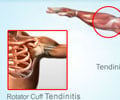A study published in the July issue of Radiology says that a minimally invasive procedure to treat tendonitis in the rotator cuff of the shoulder
A study published in the July issue of Radiology says that a minimally invasive procedure to treat tendonitis in the rotator cuff of the shoulder provides immediate symptom relief to the patient.
The study found that ultrasound-guided nonsurgical therapy significantly reduces pain from calcific tendonitis of the rotator cuff and restores lasting mobility after treatment."With this treatment, we were able to establish a single inexpensive and effective treatment for calcific tendonitis of the rotator cuff. This has never happened before," said co-author Luca M. Sconfienza, M.D., from the Unit of Radiology, IRCCS Policlinico San Donato, University of Milan School of Medicine in Milan, Italy. "Symptoms improved in patients treated with our procedure compared to non-treated patients."
Calcific tendonitis is a condition that causes the formation of small calcium deposits within the tendons of the rotator cuff in the shoulder. It is most common in adults in their 40s. In most cases, the deposits become painful and can restrict mobility of the shoulder. In minor cases, physical therapy or anti-inflammatory medications may be sufficient to address the problem until the calcifications break apart spontaneously. In severe cases, patients may require shockwave treatment or open surgery to remove the calcium. Open surgery requires a hospital stay and rehabilitation and, on rare occasions, may result in major complications, such as tendon rupture.
"This treatment could completely replace other treatments that are affected by several limitations and complications," Dr. Sconfienza said.
Ultrasound-guided percutaneous (through the skin) therapy represents an effective and inexpensive alternative to surgery that is less stressful for the patient. For the 20-minute procedure, the shoulder is anesthetized and, with ultrasound guidance, a radiologist injects a saline solution into the rotator cuff to wash the area and break up the calcium. A second needle is used to aspirate, or withdraw, the calcium residue. Recovery time is about an hour.
"People with calcific tendonitis should know that with a simple, one-time ultrasound-guided procedure, they could recover completely from the terrible pain constantly affecting their shoulder," Dr. Sconfienza said.
Advertisement
The results showed that treated patients exhibited a considerable reduction in pain and significant improvement to mobility of the affected limb after 1 month, 3 months and 1 year compared to non-treated patients. Five and 10 years after the procedure, the condition of non-treated patients had improved to the point that reported outcomes were similar to those of the treated group.
Advertisement
"There are millions of people in the world affected by calcific tendonitis," Dr. Sconfienza said. "This treatment can provide quick and inexpensive relief for all of them."
Source-Eurekalert
RAS













